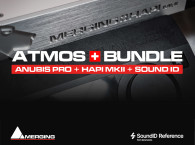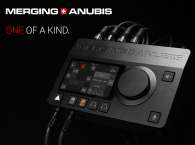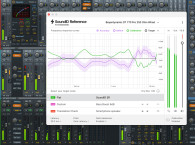
Following Merging's introduction of the latest firmware for the Anubis, giving access, for free, to the Music Mission mode, the potential of this powerful AoIP platform opened-up a new and even more exciting world of possibilities. The Monitor Mission mode can be configured according to the user's needs, in the studio or on location.
From mono to immersive setup, the Anubis Monitor Mission is the center of audio monitoring operations. The touch screen, the dedicated buttons and the encoder enable direct access from basic to advanced functions of the speaker system, headphones and cues. This includes metering, bass management, room correction, delays and downmix on all 32 output channels. Audio I/0 channels can be extended to other devices, and updating workflows for immersive audio playback is a simple process, including complete talkback setups.

Sonarworks’ popular calibration software SoundID Reference (previously Reference 4 software), can now be included in the Anubis interface and system controller, marking the first hardware to enable SoundID Reference correction outside of a computer. This partnership will provide a seamless workflow for music creators and engineers to experience accurate sound correction at the lowest possible latency on multiple outputs simultaneously.
Forget about computer latencies, forget about plugins. Users who are familiar with the power of Sonarworks' SoundID Reference can now run it directly in the Merging+Anubis hardware and get immediate headphone and room correction for studio monitors, anywhere and anytime. “Together, we’re improving the production process with accurate, high-quality sound that creators can trust”, says Sonarworks co-founder and CPO Martins Popelis.
As an audio interface, Anubis combines mastering grade speaker and headphone outputs, Merging’s acclaimed microphone preamps and line outs, as well as a complete monitoring engine. Everything is controlled from the built-in touchscreen and/or from any tablet or computer. With SoundID Reference enabled, the calibration software enables music creators to mix with confidence regardless of the source they are listening to, whether that be a computer, DAW, live mic, etc.

The calibration software operates in the background to remove unwanted coloration, delivering accurate studio reference sound at the lowest possible latency: Less than 2ms @ 44.1/48 kHz, less than 1 ms at 88.2/96kHz, and less than 0.5ms at 176.4/192kHz and DXD. No need to worry about the inserting SoundID Reference plugin or software on the DAW anymore.
Since Merging+Anubis is meant to be the center of the studio, having SoundID Reference correction running brings confidence that no matter which source the users are listening to, they can be confident Sound Reference correction is applied. While SoundID Reference standalone software offers 3 different filter types (low latency, mixed and linear phase), Anubis enables SoundID Reference correction using Pyramix acclaimed EQ-X filter topology.
EQ-X is a mastering EQ used since many years on thousands of award winning records around the world. The state space filter design of this Extreme Definition Equalizer has been specifically optimized to deal with the highest audio resolutions while still permitting very low noise & distortion, typically offering a THD+N of better than-110dB, throughout the entire audible (and even non-audible) range. Of course, this new digital filter's topology, while designed with high sample rate in mind, also offers the extra benefits and low noise to IFS equalization.

Users can also apply different SoundID Reference correction curves to as many Anubis speaker sets as they want, or recall different room profiles for a specific speaker set (example: flat or XCurve) at the touch of a button on Anubis. And SoundID Reference offers various speakers, headphones and listening environment emulations (such as NS10, laptops, cars, etc...). Anubis allows users to save all these presets and switch between them at the flip of a button, no need to go back into the SoundID Reference software.
And while SoundID Reference is a stereo only technology, Anubi users working in a surround sound setup can apply up to 84 EQ bands to any speaker set of any size (5.1, 7.1.4, 9.1.6 and more) for traditional manual room correction. It's also possible to have SoundID Reference correction running at the same time on one speaker set plus a headphone output, or two headphone outputs simultaneously (even if they require different corrections).
Existing users of Sonarworks software can also keep their existing correction files, even from previous software versions, load them in the latest SoundID Reference software and export the required files for Anubis. SoundID Reference runs on both the Anubis Monitoring Mission and the Music Mission with a simple firmware update.
“It was always our dream to add productivity and utility features to Anubis and this partnership with SoundID Reference exactly fulfills that,” comments Claude Cellier, Merging’s Founder and President. “So many of our customers will welcome the ability to easily calibrate their listening environment where Anubis is already their critical monitoring unit.”
www.sonarworks.com
www.merging.com








